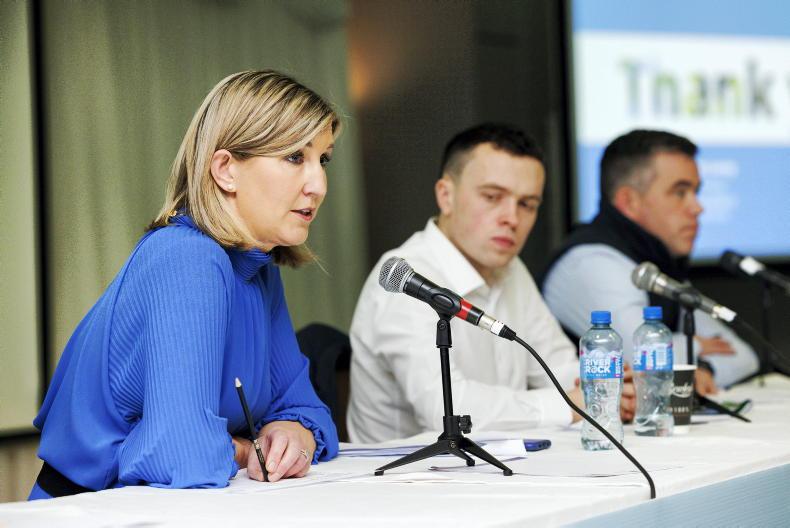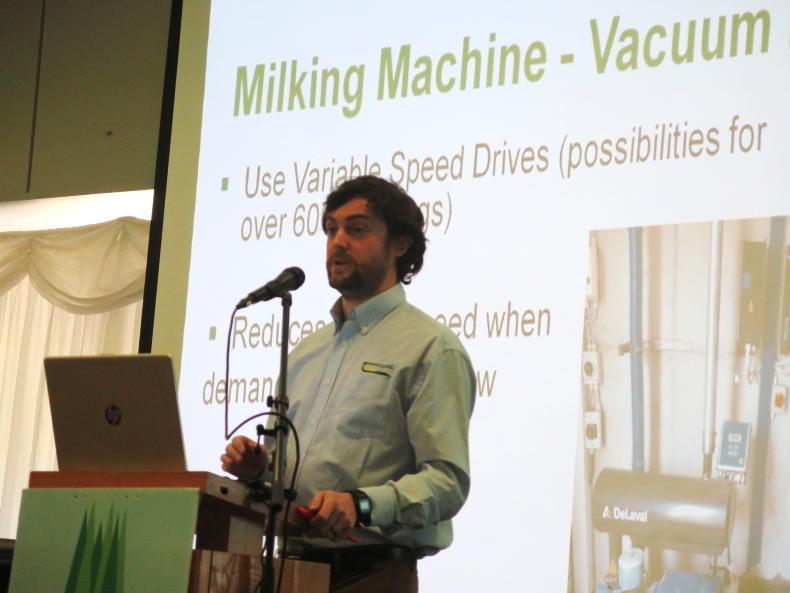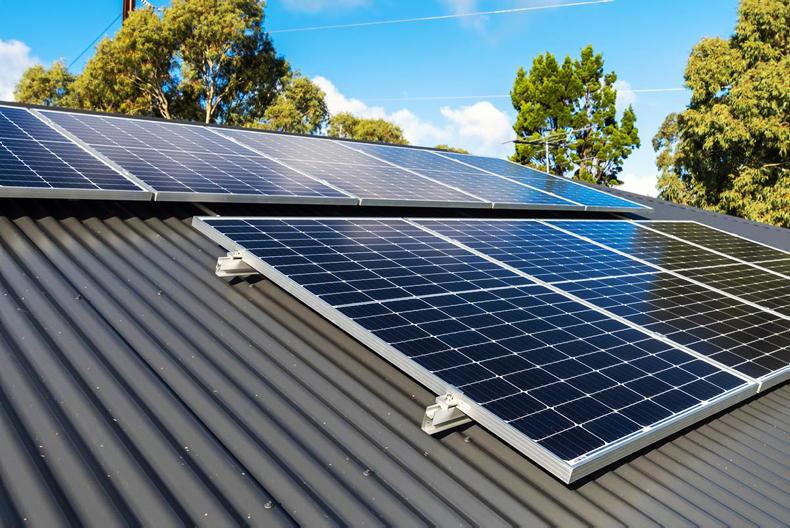Farmers in the high band for nitrates got a rude awakening at the Irish Grassland Association dairy conference last week.
According to ifac’s head of banking Noreen Lacey, dairy farmers in the high band for nitrates who do not increase land area are facing a 53% cut in income.
Noreen explained that these stark figures are based on a typical farm of 40ha, which in the base scenario was milking 112 cows at 2.8 cows/ha, producing 6,800l of milk per cow per year, feeding 1.35t of meal per cow per year and making a profit of €133,123 when the recieved milk price is 50c/l. Noreen said that all costs are based on the average costs for ifac clients.
Because this herd is producing over 6,500kg of milk annually, it is now classed as being in the top band for nitrates, meaning the nitrogen excretion rate per cow has increased from 89kg N to 106kg N per cow.

Noreen Lacey, head of banking, ifac, presenting the financial costs of new environmental regulations at the Irish Grassland Association dairy conference in Charleville, Co Cork.
For 2023, presuming land area stays the same, this example herd would need to reduce cow numbers by 18 cows in order to remain under 250kg N/ha, which is the upper limit of organic nitrogen per hectare for farms availing of a nitrates derogation. According to Noreen’s analysis, this would reduce profitability by 33% to €88,881 for the farm.
Importantly, Noreen pointed out that in her analysis variable costs reduce when cow numbers reduce. She said that fixed costs are not expected to reduce, however, because these are in effect sunk costs based on the current number of cows being milked on the farm.
Water quality review
Next, Noreen looked at the impact of reducing the upper organic nitrogen limit for derogation farmers from 250kg N/ha to 220kg N/ha.
This is a measure contained in the new nitrates action programme, which is set to come into place after a review of water quality later this year.
“If the derogation goes from 250kg to 220kg cow numbers reduce from 112 to 83 and the stocking rate is reduced down, which has a huge impact on milk sales and results in a 53% reduction in profit to €62,874.
“There is going to be a huge impact on farmers in that band, in particular.
“The assumptions we’ve taken are based on ifac clients but everyone needs to sit down and do their own figures on a case-by-case basis,” Noreen said.
She then went on to examine in more detail two alternative strategies for dealing with the changes – leasing more land and reducing milk production.
In the leased land scenario, an additional 20 acres were leased at a cost of €300/acre and cow numbers remained at 112.
All other costs, including fertiliser costs remained the same as they were with 40ha being farmed, with the result that the only additional cost was the extra land lease. As a result, profitability only dropped by 5% to €127,000.
“The price you pay for that leased land: at what point does it become uncommercial for you to do it? That can only be worked out on a case-by-case basis, so every farmer needs to look at their figure and some farmers with higher costs won’t be able to pay the same amount for it.”
Reduce milk yield
Noreen also looked at a second option and that is to reduce milk yield by feeding less concentrates.
In this scenario, Noreen assumed that milk yield would drop by 550l per cow per year if 150kg less meal is fed per cow. Her analysis showed that profitability would fall by 23% to €102,411 under this scenario. It’s important to note that both scenarios are based on 250kg N/ha. Significant further reductions in profit would be incurred at a 220kg N/ha limit.
It is notoriously difficult to assume response to concentrate rates at farm level.
In Moorepark research, response rates are typically 0.7kg to 0.8kg of milk for every additional kilo of meal fed.
Most researchers would acknowledge that this is likely to be lower at farm level because of more spread-out calving patterns or poor-performing cows that still get fed meal but don’t give a return in milk for it.
Let’s face it, there is not enough land in Ireland to satisfy everyone so that option just won’t be available to everyone
If a more realistic response to concentrate was assumed of say 0.8kg of milk for every 1kg of meal fed and if this was equated on a dry matter basis, then 708kg DM of meal could be saved and milk yield would drop by 550l to under 6,500kg/cow and the herd would be in the middle band for nitrates.
This would mean total feed levels would be 518kg DM/cow or 609kg fresh weight per cow.
At a cost of €440/t fresh weight this works out at a total cost of €28,939. Under this revised low meal feeding scenario, the profitability would be the same as the base scenario.
For me, Noreen Lacey’s presentation highlights the importance for farmers of making sure they stay out of the high band for milk, if at all possible.
Feeding high levels of meal to produce more milk per cow only to be severely penalised for that on nitrates banding and overall stocking rate doesn’t make sense.
I agree that leasing more land will be the least costly option for most dairy farmers but, let’s face it, there is not enough land in Ireland to satisfy everyone so that option just won’t be available to everyone.
The payback period for installing solar photovoltaic panels on dairy farms could be as little as three years, Teagasc researcher John Upton said at the IGA conference.

John Upton speaking at the Irish Grassland Association dairy conference in Charleville, Co Cork.
He said that a new 60% grant aid is being proposed in the incoming TAMS and that if this is availed of, the payback period can be reduced to just three years.
Not only this, but the clean export guarantee can also be claimed which will pay farmers 14c to 20c per unit of electricity exported to the grid. In a change from the existing TAMS, farmers who draw down the new TAMS grant can also avail of this payment for electricity exported to the grid, he says.

Solar PV panels on a shed.
John said that battery storage is also likely to be grant-aided under the new TAMS, which is likely to have a total investment ceiling of €90,000 with 60% grant aid.
However, he cautioned farmers against jumping to battery storage without considering other options first.
He said that electric water storage heaters or ice-bank bulk tanks are useful at using electricity generated by solar at off peak times and storing that energy. In terms of sizing, he said that if farmers claim a TAMS grant for a solar project, they will be limited to the size for self-consumption, typically 25,000kWh for a 100-cow farm.
In terms of grid connection, he said that the mini generation scheme which was announced in 2022 has a maximum size of 17kWp for a single-phase supply.
While it is 50kWp for a three-phase supply, the maximum import capacity for most farms is 29kVa.
John said that farmers should consider other energy-saving devices, such as plate coolers and variable speed drives to reduce their electricity usage, before considering renewable energy as these have a shorter payback.
He said that variable speed drives are particularly cost-effective for farmers with three phase but are more expensive in single-phase supply.
Farmers in the high band for nitrates got a rude awakening at the Irish Grassland Association dairy conference last week.
According to ifac’s head of banking Noreen Lacey, dairy farmers in the high band for nitrates who do not increase land area are facing a 53% cut in income.
Noreen explained that these stark figures are based on a typical farm of 40ha, which in the base scenario was milking 112 cows at 2.8 cows/ha, producing 6,800l of milk per cow per year, feeding 1.35t of meal per cow per year and making a profit of €133,123 when the recieved milk price is 50c/l. Noreen said that all costs are based on the average costs for ifac clients.
Because this herd is producing over 6,500kg of milk annually, it is now classed as being in the top band for nitrates, meaning the nitrogen excretion rate per cow has increased from 89kg N to 106kg N per cow.

Noreen Lacey, head of banking, ifac, presenting the financial costs of new environmental regulations at the Irish Grassland Association dairy conference in Charleville, Co Cork.
For 2023, presuming land area stays the same, this example herd would need to reduce cow numbers by 18 cows in order to remain under 250kg N/ha, which is the upper limit of organic nitrogen per hectare for farms availing of a nitrates derogation. According to Noreen’s analysis, this would reduce profitability by 33% to €88,881 for the farm.
Importantly, Noreen pointed out that in her analysis variable costs reduce when cow numbers reduce. She said that fixed costs are not expected to reduce, however, because these are in effect sunk costs based on the current number of cows being milked on the farm.
Water quality review
Next, Noreen looked at the impact of reducing the upper organic nitrogen limit for derogation farmers from 250kg N/ha to 220kg N/ha.
This is a measure contained in the new nitrates action programme, which is set to come into place after a review of water quality later this year.
“If the derogation goes from 250kg to 220kg cow numbers reduce from 112 to 83 and the stocking rate is reduced down, which has a huge impact on milk sales and results in a 53% reduction in profit to €62,874.
“There is going to be a huge impact on farmers in that band, in particular.
“The assumptions we’ve taken are based on ifac clients but everyone needs to sit down and do their own figures on a case-by-case basis,” Noreen said.
She then went on to examine in more detail two alternative strategies for dealing with the changes – leasing more land and reducing milk production.
In the leased land scenario, an additional 20 acres were leased at a cost of €300/acre and cow numbers remained at 112.
All other costs, including fertiliser costs remained the same as they were with 40ha being farmed, with the result that the only additional cost was the extra land lease. As a result, profitability only dropped by 5% to €127,000.
“The price you pay for that leased land: at what point does it become uncommercial for you to do it? That can only be worked out on a case-by-case basis, so every farmer needs to look at their figure and some farmers with higher costs won’t be able to pay the same amount for it.”
Reduce milk yield
Noreen also looked at a second option and that is to reduce milk yield by feeding less concentrates.
In this scenario, Noreen assumed that milk yield would drop by 550l per cow per year if 150kg less meal is fed per cow. Her analysis showed that profitability would fall by 23% to €102,411 under this scenario. It’s important to note that both scenarios are based on 250kg N/ha. Significant further reductions in profit would be incurred at a 220kg N/ha limit.
It is notoriously difficult to assume response to concentrate rates at farm level.
In Moorepark research, response rates are typically 0.7kg to 0.8kg of milk for every additional kilo of meal fed.
Most researchers would acknowledge that this is likely to be lower at farm level because of more spread-out calving patterns or poor-performing cows that still get fed meal but don’t give a return in milk for it.
Let’s face it, there is not enough land in Ireland to satisfy everyone so that option just won’t be available to everyone
If a more realistic response to concentrate was assumed of say 0.8kg of milk for every 1kg of meal fed and if this was equated on a dry matter basis, then 708kg DM of meal could be saved and milk yield would drop by 550l to under 6,500kg/cow and the herd would be in the middle band for nitrates.
This would mean total feed levels would be 518kg DM/cow or 609kg fresh weight per cow.
At a cost of €440/t fresh weight this works out at a total cost of €28,939. Under this revised low meal feeding scenario, the profitability would be the same as the base scenario.
For me, Noreen Lacey’s presentation highlights the importance for farmers of making sure they stay out of the high band for milk, if at all possible.
Feeding high levels of meal to produce more milk per cow only to be severely penalised for that on nitrates banding and overall stocking rate doesn’t make sense.
I agree that leasing more land will be the least costly option for most dairy farmers but, let’s face it, there is not enough land in Ireland to satisfy everyone so that option just won’t be available to everyone.
The payback period for installing solar photovoltaic panels on dairy farms could be as little as three years, Teagasc researcher John Upton said at the IGA conference.

John Upton speaking at the Irish Grassland Association dairy conference in Charleville, Co Cork.
He said that a new 60% grant aid is being proposed in the incoming TAMS and that if this is availed of, the payback period can be reduced to just three years.
Not only this, but the clean export guarantee can also be claimed which will pay farmers 14c to 20c per unit of electricity exported to the grid. In a change from the existing TAMS, farmers who draw down the new TAMS grant can also avail of this payment for electricity exported to the grid, he says.

Solar PV panels on a shed.
John said that battery storage is also likely to be grant-aided under the new TAMS, which is likely to have a total investment ceiling of €90,000 with 60% grant aid.
However, he cautioned farmers against jumping to battery storage without considering other options first.
He said that electric water storage heaters or ice-bank bulk tanks are useful at using electricity generated by solar at off peak times and storing that energy. In terms of sizing, he said that if farmers claim a TAMS grant for a solar project, they will be limited to the size for self-consumption, typically 25,000kWh for a 100-cow farm.
In terms of grid connection, he said that the mini generation scheme which was announced in 2022 has a maximum size of 17kWp for a single-phase supply.
While it is 50kWp for a three-phase supply, the maximum import capacity for most farms is 29kVa.
John said that farmers should consider other energy-saving devices, such as plate coolers and variable speed drives to reduce their electricity usage, before considering renewable energy as these have a shorter payback.
He said that variable speed drives are particularly cost-effective for farmers with three phase but are more expensive in single-phase supply.









 This is a subscriber-only article
This is a subscriber-only article










SHARING OPTIONS: